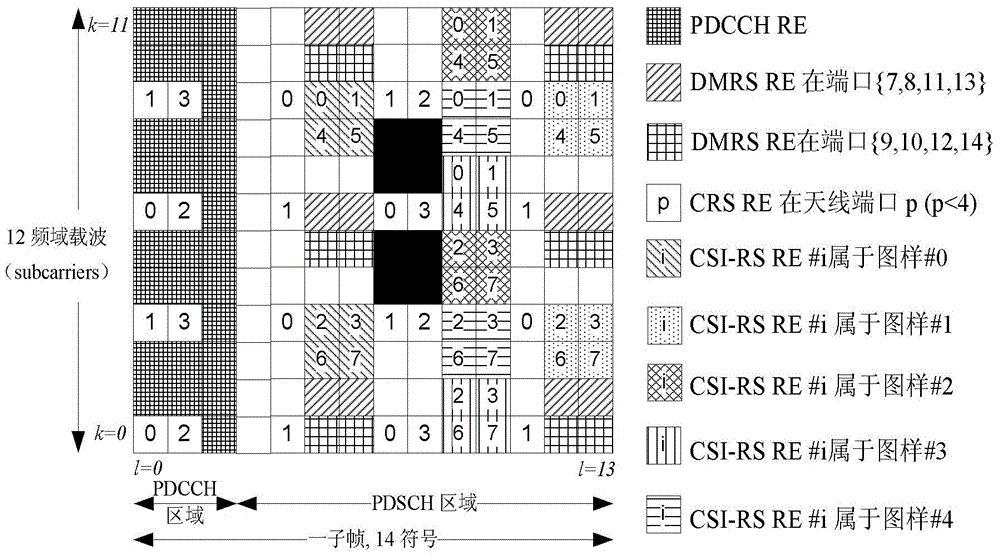Downlink pilot frequency transmission method, detection method, device, base station, and terminal
A transmission method and base station technology, applied in the field of terminals, detection methods, downlink pilot transmission methods, devices and base stations, can solve problems such as poor performance and poor application performance
- Summary
- Abstract
- Description
- Claims
- Application Information
AI Technical Summary
Problems solved by technology
Method used
Image
Examples
Embodiment 1
[0189] Embodiment 1. A method for sending downlink pilots, such as Figure 5 As shown, including steps S110-S130:
[0190] S110. The base station divides the resource to be sent the downlink measurement pilot signal into multiple resource groups; the resource includes any one of subframe, port, PRBpair or any combination thereof.
[0191] S120. The base station separately configures and / or agrees with the terminal on the pilot transmission parameters of each resource group.
[0192] S130. The base station transmits downlink measurement pilot signals in each resource group according to the pilot transmission parameters configured for each resource group and / or agreed with the terminal.
[0193] In this embodiment, the base station may notify the terminal through configuration signaling or agree with the terminal on the grouping information of the resource group.
[0194] In an implementation manner of this embodiment, the pilot parameter configuration is performed for time-do...
example 1
[0243] Example 1: TTI (Transmission Time Interval) groups are configured with pilot parameters respectively, at the base station side.
[0244] Sub-example 1 of Example 1: subframe grouping:
[0245] The base station divides the M subframes to be transmitted downlink measurement pilot signals in the time domain into N subframe groups: subframe group 1, subframe group 2...subframe group N, where N is less than or equal to M. Each subframe group Can contain 1 or more subframes.
[0246] (1) The case of periodic pilots
[0247] The base station sends periodic pilots to the terminal, and for the periodic pilots, the base station does not expect to restrict all subframes for sending periodic pilots to have exactly the same pilot transmission parameters. Therefore, the base station groups subframes into groups, and several simple grouping methods such as Figure 6a As shown, one is to divide subframe 0 in each frame into subframe group 1, and subframe 5 into subframe group 2; the...
example 2
[0286] Example 2: Port groups are configured with pilot parameters respectively, on the base station side.
[0287] Sub-example 1 of Example 2: Port grouping:
[0288] The base station divides the X ports to be transmitted downlink measurement pilot signals into Y port groups: port group 1, port group 2... port group Y, where Y is less than or equal to X. Each port group can contain 1 or multiple ports.
[0289] Examples of several simple port grouping methods are as follows.
[0290] Method 1: block grouping method, each block is a group, such as Figure 7 shown.
[0291] Method 2: Row grouping method: the antenna port of each row is an antenna group such as Figure 8 shown.
[0292] Method 3: Polarization grouping method: An antenna port for each polarization direction is an antenna group, such as Figure 9 shown.
[0293] There are also some mixed methods for grouping, such as the combination of method 3 and method 1, the combination of method 3 and method 1, etc. T...
PUM
 Login to View More
Login to View More Abstract
Description
Claims
Application Information
 Login to View More
Login to View More - R&D
- Intellectual Property
- Life Sciences
- Materials
- Tech Scout
- Unparalleled Data Quality
- Higher Quality Content
- 60% Fewer Hallucinations
Browse by: Latest US Patents, China's latest patents, Technical Efficacy Thesaurus, Application Domain, Technology Topic, Popular Technical Reports.
© 2025 PatSnap. All rights reserved.Legal|Privacy policy|Modern Slavery Act Transparency Statement|Sitemap|About US| Contact US: help@patsnap.com



